A 1960s Australian venture to create a low cost agricultural Tiger Moth replacement
Compiled by Geoff Goodall

Tiger Moths had been the mainstay of Australian aerial agriculture since its inception in 1947. RAAF disposals Tiger Moths were plentiful and cheap with seemingly limitless supplies of spare parts and Australian wartime production Gipsy Major engines. Literally hundreds of DH.82s had been converted to crop sprayers, dusters, seeders and spreaders. Many smaller businesses would struggle to raise the financing required to replace their Tigers with modern aircraft specifically designed for agricultural operations, like the Piper PA-25 Pawnee, CallAir A-9 and Yeoman YA-1 Cropmaster.
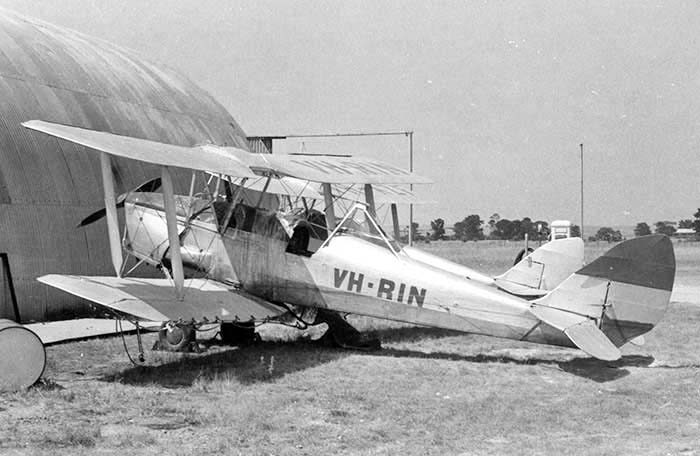
It was a typical ag Tiger fitted with an overturn truss to protect the pilot. Photo by Peter Limon
In July 1963 he purchased an airworthy Chipmunk VH-AMB, dismantled it in his Goulburn hangar and commenced metal work to modify the fuselage to his agricultural design. After an inspection by a DCA airworthiness surveyor rejected his modifications thus far, Sasin approached a small Sydney aeronautical engineering consultancy Aerostructures Pty Ltd at Bankstown Airport.
Aerostructures had been established by Sydney aeronautical engineer C.W. (Bill) Smith who had previously designed agricultural aircraft including the Yeoman YA-1 Cropmaster 250. Smith had been a Director of Yeoman Aviation and in 1964 set up his own business Aerostructures with his chosen design team. Aerostructures specialised as consultant aeronautical designers, gaining DCA approval for a range of light aircraft modifications. Refer: http://www.goodall.com.au/australian-aviation/wackett-cropmaster/wackett-cropmaster.htm
Sasin formed a 50/50 partnership with Aerostructures' senior aeronautical enginer Mike Burns. The project was named Sasin-Aerostructures Spraymaster with design number SA-29, implying it was Aerostructures' 29th project. Aerostructures commenced work on a revised design and submitted professional engineering drawings and stress analysis calculations to DCA for approval. Meanwhile a replacement fusalage was acquired for the prototype. The project was slowed by the lengthy DCA approval process for various components of the design. The Department's airworthiness branch at that time had a well-earned reputation for an ultra-conservative attitude towards modifications and variations to aircraft Type Certificates. DCA determined that the radical changes proposed for the humble Chipmunk trainer required a new Type Certificate and and Aerostructures would be required to comply with all stringent requirements to gain that certification. Mike Sasin's plans for a quick and cheap ag Tiger replacement were dashed but he still saw potential as a cheaper alternative to imported Piper and Cessna ag planes.
As costs increased there were further delays while additional financing was sought. Orders were secured from crop spraying businesses in SA and WA. DCA required an extensive test flying program to measure performance. Hawker De Havilland at Bankstown offered their company test pilot but Sasin considered the fee too high. He gained the DCA test pilot qualification himself and did most of the flying, using the cruise flight hours to visit Goulburn to show the new aeroplane to his financial backers and spraying customers.
The SA-29 modifications to the DHC-1 airframe included:
- rear pilot seat retained but raised
- front seat and controls removed and replaced by a chemical hopper
- clipped wings with endplates in lieu of slots
- enlarged low drag "blown" canopy to increase pilot's field of view, offered as clear or tinted
- anti-spin strakes between rear fuselage and horizontal tailplane
- fin fillet
- spring-leaf tailwheel assembly
- overturn truss for pilot protection
- trailing edge wing spraybars and spray pump system, and alternative belly drop hatch for spreading of dry fertiliser or seed
"Engineering and design now became my interest. The complete redesigning of a Chipmunk aircraft for aerial spraying resulted in a completely new type of plane registered as a SA-29 Spraymaster. This was exacting work because of the strict requirements and regulations covering aircraft design at that time. After about a year of development at Goulburn, the new plane was built over a period of two years at Bankstown Airport, Sydney. Mike Burns, an aeronautical engineer also associated with the development of the plane and I were in a 50-50 partnership and planned to convert more Chipmunk aircraft to the new design. We already had orders and further plans to start production of a more powerful version of the Spraymaster. Financially we were under considerable strain but the future looked good.
After the Certificate of Airworthiness was issued I flew it back to Goulburn. Later that day one of the local pilot instructors took the plane up for as familiarisation flight, ran out of fuel and crashed it. The pilot surtvived but the plane was a complete wreck. It was the end of all our hard work.
There were aerial spraying contracts to fulful so I bought a Piper Pawnee 150 VH-SFF to get on with the work. Two weeks later on December 3rd 1965 while carrying out a spraying job for a local farmer, I crashed the aircraft and was badly hurt and hospitalised. I realised I could no longer fly as a result of the head injuries I suffered. I did not feel I could carry on the business of developing the Spraymaster. While still in hospital I held a meeting with my solicitor and Mike Burns, the outcome being I signed everything over to Mike. My life had changed so drastically I now wanted to move on away from the scene of so much sadness. I was offered a position in Western Australia as chief engineer of a spraying company. Four months after the Pawnee acciden I took up the position and moved my wife and children to a new life in WA."
Aerostructures Sundowner
To supplement charter work Roulston had pioneered aerial mustering of sheep and cattle on properties in the Murchison district inland from Carnarvon. He was looking for a specialised mustering aircraft to replace the Cessnas he was using. Roulston was very familiar with the Chipmunk from nine years as an instructor with the Royal Aero Club of WA's large fleet of Chipmunks. Among aircraft he used for mustering was a Chipmunk VH-UEZ which he found suitable for the task, but it was quickly lost in an accident. By early 1966 Roulston had ordered the first Sundowner, which was proposed to be a SA-29 less agricultural hopper and fittings with a modern Lycoming engine. Prospects for aerial mustering were good and his purchase contract included options for additional Sundowners. Aircraft magazine reported in April 1966 "Nor'West Air Taxis are noted for their aerial mustering on stations around Carnarvon. They are believed to have ordered a fleet of Aerostructures Sundowners."
| - Lycoming O-360 engine and new cowling design - both pilot seats retained but raised for better visibility - cockpit controls and instruments modernised - streamlined enlarged front seat windscreen - one piece frameless "blown" canopy - wings fabric areas covered with metal skinning, with provision for luggage lockers - wing tip fuel tanks - SA-29 features including anti-spin strakes, fin fillet and spring-leaf tailwheel mounting |
Aerostructures offered a design and stress-analysis service to gain DCA approval for airframe modifications, changes of engine type etc. The company employed aeronautical engineers on a wide variety of projects, believed to include the first Australian modification of Piper PA-25 Pawnees to two-seaters in 1966 to carry a loader-driver and allow pilot training.
| Aerostructures name | DCA Type Designation | Aircraft |
| SA-29 Spraymaster | DHC-1/SA-29 | VH-SJD |
| SA-29 Spraymaster | DHC-1/SA-29 | VH-BCA |
| SA-29 Spraymaster | DHC-1/SA-29 | VH-GEB |
| Sundowner | No type certification | VH-CXZ |
| Sundowner (partial) | DHC-1/A1 | VH-RJK |
| Based on airframe of DHC.1 Chipmunk Mk.21 VH-AMB c/n C1-0383 | |
| 30.11.51 Built by De Havilland Aircraft Co Ltd at their Hawarden Aerodrome factory, Chester Fuselage number DHB f301. Diverted from RAF production line for the civil market. Sold to Royal Aero Club of Western Australia and boxed for shipping to Perth WA 8.1.52 Registered as Chipmunk Mk.21 VH-AMB Royal Aero Club of WA 9.4.62 Sold to Mid-Murray Flying Club, Swan Hill Vic 10.5.62 Departed Perth on delivery flight to Swan Hill. Retained RAeCWA all red paint scheme. 1.7.63 Sold to Sasin Aircraft Service Ltd, Goulburn NSW | |
| 7.63 | VH-AMB delivered Swan Hill to Goulburn, flown by Mike Sasin. |
| .63 | Dismantled by
Sasin in his hangar at Goulburn and work commenced on modifications to
replace the front seat installations with an agricultural liquid
chemical hopper. |
| Sasin went into partnership with Aerostructures Pty Ltd, Bankstown Airport, Sydney to complete the conversion and
gain Department of Civil Aviation Aircraft Type Certificate approval
for the highly modified Chipmunk. The project was designated Sasin-Aerostructures SA-29 Spraymaster | |
| .63 | VH-AMB moved by road from Goulburn to Bankstown |
| DCA would not approve the initial modification metal work carried out on VH-AMB's fuselage by Sasin at Goulburn. A replacement fuselage was needed. | |
| Replacement fuselage acquired from Tamatave Aero Club, New Caledonia from DHC.1 F-OAOL c/n C1-0438 ex WG351. It had been dismantled and used for parts. | |
| 8.51 Construction completed by De Havilland Aircraft Co Ltd at Hawarden, Chester to RAF order Fuselage number DHB f300. 10.8.51 Taken on RAF charge as Chipmunk T.Mk.10 WG351 10.8.51 No.47 Maintenance Unit, Hawarden for packing and transport to Birkenhead Docks 2.10.51 Departed on SS Clan Sinclair for Durban, where arrived 21.10.51 17.11.51 394 Maintenance Unit Heany for assembly for Southern Rhodesian Air Force 1.1.52 No.5 Flying Training School, Thornhill 17.6.53 No.4 Flying Training School, Heany for disposal 29.10.53 Sold to civil purchaser 29.10.53 Airfreighted from Bulawayo to Tananarive via Mozambique French island Juan de Nova 17.12.54 Registered F-OAOL Tamatave Aero Club, New Caledonia 29.5.55 Registration suspended, probably due accident Stored dismantled by Tamatave Aero Club for spare parts use | |
| 7.65 | First flight as SA-29 at Bankstown, painted as VH-SJD with Sasin Aircraft Service titles. |
| 7.65-8.65 | Test flying program measure performance as part of the DCA certification process for a new aircraft type. Test flying was carried out by Mike Sasin, during which he visited Goulburn to show his new aircraft to local businessmen who had financed him and farmer customers. |
| 31.8.65 | VH-AMB struck-off Register |
| 1.9.65 | Registered as DHC1/SA29 VH-SJD: Sasin Aircraft Service Ltd, Goulburn NSW |
| 1.9.65 | CofA issued under new DCA Australian Type Certificate as a SA29 |
| 2.9.65 | Delivered
Bankstown-Goulbourn by Sasin. At Goulburn he made local flights to
demonstrate the SA-29 and later in the day invited Goulburn aero club
instructor A.Cummins to make a flight. Soon after takeoff the aircraft
ran out of fuel and crashed, pilot was seriously injured and aircraft
wrecked. |
| 2.9.65 | Crashed, destroyed Goulburn NSW |
| DCA accident report summary: Shortly after take-off engine power was lost due to fuel exhaustion. The pilot attempted to return to the aerodrome, but the aircraft stalled and dived almost vertically into the ground. |
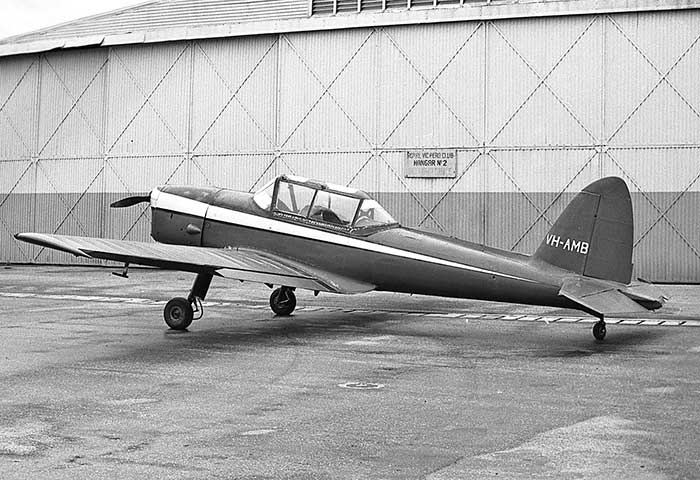
Mid-Murray Flying Club Chipmunk VH-AMB visits Moorabbin Vic March 1963, allover red with white stripe.
Three months later it was sold to Mike Sasin to become the first SA-29. Photo by Bob Neate
Three months later it was sold to Mike Sasin to become the first SA-29. Photo by Bob Neate
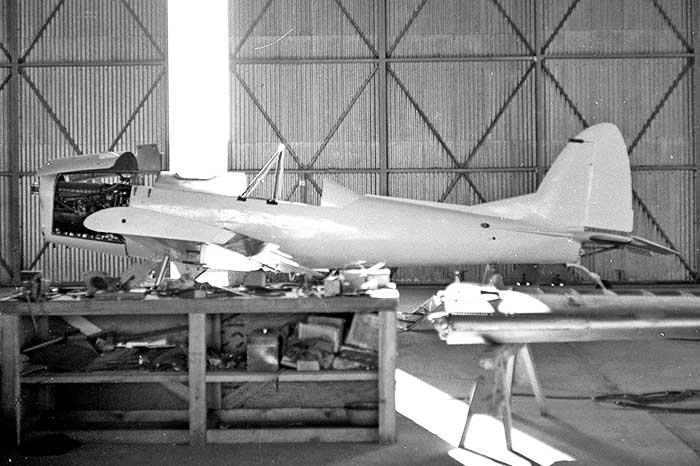
Photo by John Hopton
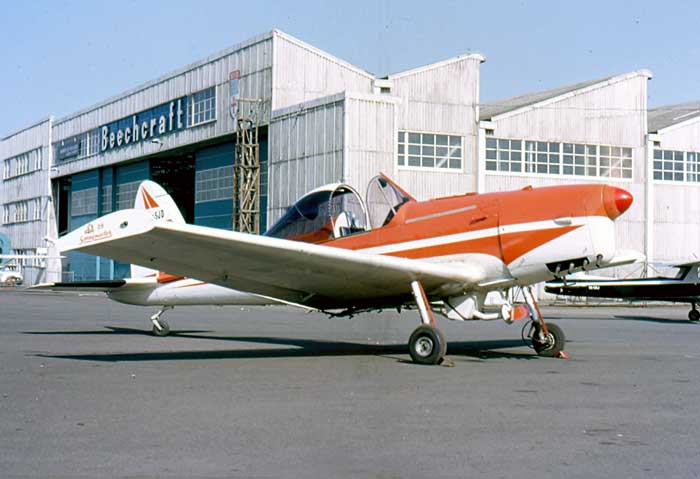


Photo by Neville Parnell
| Based on airframe of Chipmunk WB601 c/n C1-0042 acquired from spare parts stock of Royal Newcastle Aero Club. Some parts of VH-RNJ from the same source were included | |
| 21.2.50 Construction date by De Havilland Aircraft Co Ltd at Hawarden, Chester to RAF order Fuselage number DHH f46. 31.3.50 Taken on RAF charge as WB601 11.4.50 Edinburgh University Air Squadron 29.5.53 RAF College, Cranwell 8.9.53 No.20 Maintenance Unit, Ashton Down for storage 25.6.56 Sold to W.S.Shackleton Ltd, London. Dismantled at Ashton Down by Helliwells Ltd acting for W.S.Shacklton, transported to Avonmouth for shipping to Australia. WB601 was not assembled in Australia as a civil aircraft, acquired by Royal Newcastle Aero Club for parts. The Club operated a large Chipmunk fleet from Broadmeadow airfield, Newcastle before moving in 1960 to West Maitland (Rutherford). In August 1964 Royal Newcastle Aero Club advertised for sale its spares Chipmunk fuselages and wi | |
| .64 | Dismantled airframes WB601 and VH-RNJ plus other parts purchased by Aerostructures Pty Ltd, Hangar 120 Bankstown Airport, Sydney NSW |
| 2.8.65 | Second SA-29 noted under assembly in Aerostructures hangar Bankstown |
| 11.9.65 | noted completed at Bankstown completed, painted as VH-BCA |
| 21.9.65 | Registered as DHC1/SA29 VH-BCA Bob Couper Pty Ltd, Cunderdin WA |
| 9.65 | Delivered from Bankstown to Cunderdin by Alan Fox, chief pilot of Bob Couper Pty Ltd |
| 1.10.65 | Visited an airshow at Rockingham WA |
| 65-72 | Based
Cunderdin WA operated as an agricultural sprayer and duster. Loaned to
Gliding Club of WA also based at Cunderdin when required as a glider
tug. |
| 20.8.70 | Minor
damage near Korrelocking WA. The engine was being hand-started by
having the propeller swung when the aircraft, which had no wheels
chocks, rolled forward and struck farm machinery. |
| 1.11.70 | Visited an airshow at Beverley WA, towed a glider airborne |
| 28.12.70 | Propeller
detached while towing a glider at Cunderdin. VH-BCA and the glider made
successful forced landings alongside the runway without damage |
| 14.11.71 | Visited an airshow at Northam WA, towed a glider airborne |
| 14.2.72 | Struck-off Civil Register at owner's request, retired |
| 28.10.72 | VH-BCA
noted at Kellerberrin WA on Alan Mather's farm airstrip. Now owned by
agricultural operator John Turner. Also noted at Kellerberrin 1.3.73. |
| 22.12.73 | noted at Jandakot Airport, Perth parked outside at the agricultural hangar area. Also 8.1.74, 8.3.74 |
| 25.5.74 | noted at Jandakot Airport, Perth now parked outside at Bernies Aviation area. Also 2.6.74 |
| 7.6.74 | no longer at Jandakot |
| 11.2.75 | noted at Kellerberrin WA in maintenance hangar |
| 13.7.75 | Restored to Register VH-BCA: John A Turner, Perth WA trading as Austral Aviation |
| Operated as an agricultural sprayer based at Kellerberrin WA | |
| 19.9.76 | Change of ownership: Cliff Brown Piper West Pty Ltd, Jandakot Airport, Perth WA Traded in on PA-25 Pawnee 235 VH-PXI |
| 9.76 | Advertised for sale by Cliff Brown Piper West: Total airframe time 2,415 hours |
| 8.10.76 | Change of ownership: Robert J. Moro, Cairns Qld |
| 76-77 | Operated as a glider tug by Far North Queensland Soaring Club, Mareeba Qld. Club ceased using VH-BCA during 1977 due poor performance and engine maintenance problems. |
| 6.10.77 | Struck-off Register at owner's request. |
| 77-85 | Retired, parked in the open at Mareeba Qld. Painted faded badly in tropical climate. |
| 86 | Acquired
by Cliff Douglas,
moved by road to Coolangatta Qld for restoration. Most agricultural
fittings were removed and aircraft painted in a stylish new scheme as a
single seater aerobatic aircraft. Retained the fin fillet and bubble
canopy. |
| 10.12.86 | Restored to Register as DHC-1 Chipmunk T Mk.10: Cliff C. Douglas, Chewing Gum Field Air Museum, Tallebudgera Qld |
| 90s-03 | Loaned to Museum of Australian Army Flying, Oakey Army Airfield Qld |
| .03 | Acquired
by Michael Spaulding trading as Cairns Airport Hangars, Cairns Qld. Mike Spaulding had established North Queensland Warbirds based at the former WWII airfield at Mareeba, near Cairns. |
| 17.4.03 | Arrived at Mareeba Qld by road from Oakey Qld |
| Rebuilt at Mareeba back to
standard Chipmunk two seat dual controls trainer configuration. When completed, painted in silver RAF scheme. | |
| 7.6.04 | Civil Register Change of ownership: Cairns Airport Hangars Pty Ltd, Cairns Qld Operated by associate company North Queensland Warbirds, Mareeba Airport Qld |
| 10.8.13 | Change of ownership: Edward B. Harvey, Bannockburn Vic |
| 16.10.21 | Change of ownership: Malcolm B. Thompson, Melbourne Vic |
| Current |
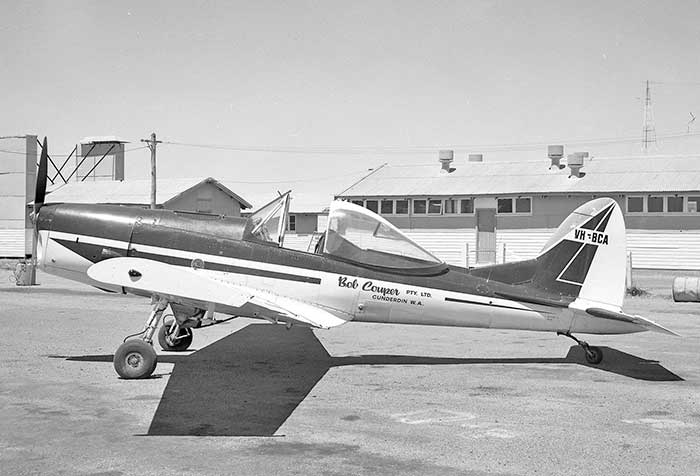
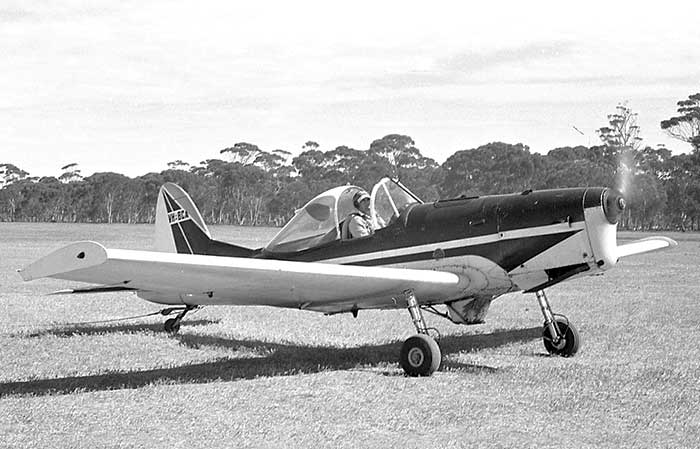
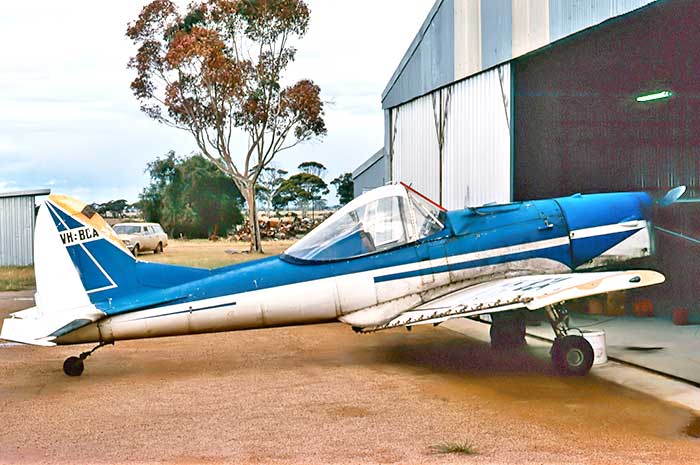
Photo by David Tanner
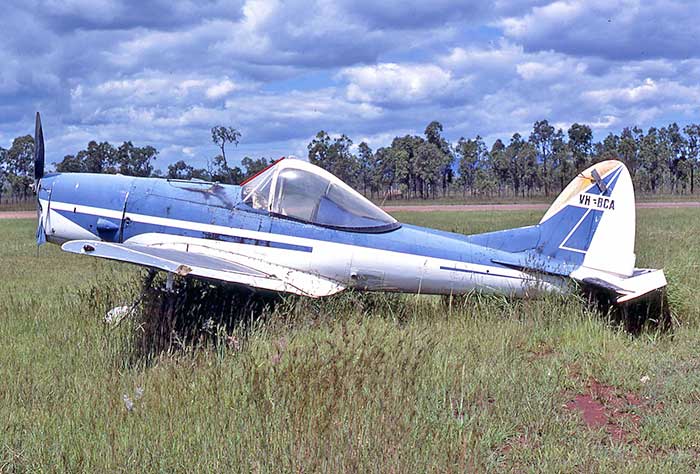
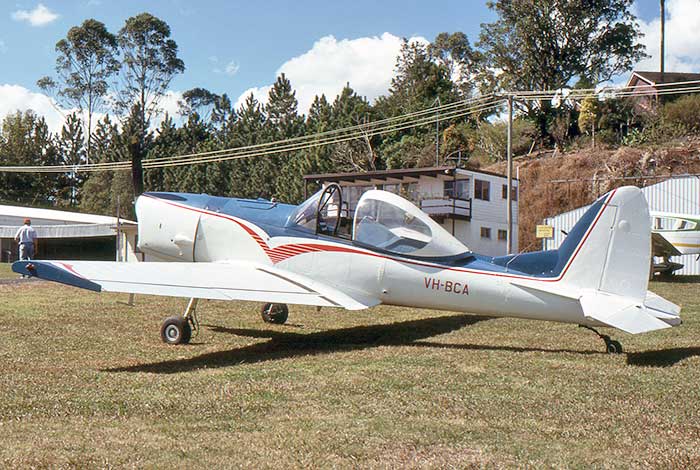
Looking much happier at Murwillumbah NSW in August 1990, after a restoration as a single-seat sport aircraft.
Although most agricultural gear was removed, the hopper door can be seen ahead of the cockpit.
Photo by Ben Dannecker
Although most agricultural gear was removed, the hopper door can be seen ahead of the cockpit.
Photo by Ben Dannecker

although retaining the spring-leaf tailwheel and anti-spin strakes. Photo by Paul Howard
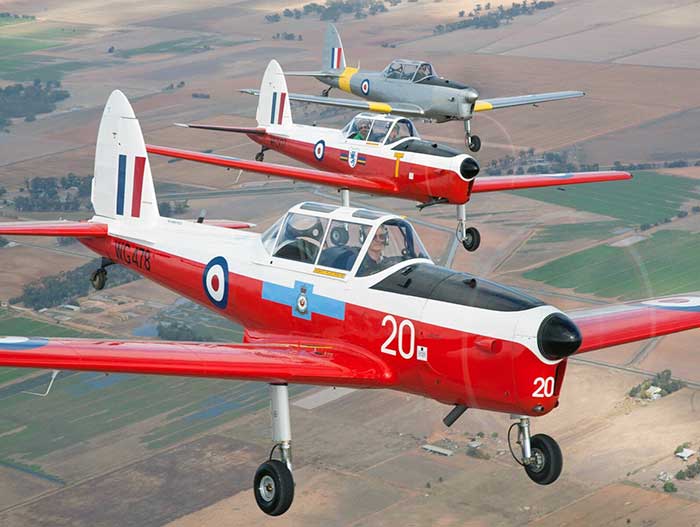
Photo courtesy Rod Blievers who was flying his VH-MMS nearest to the camera aircraft.
| Based on DHC.1 Chipmunk VH-BSQ c/n C1-0501 acquired from Tasmanian Aero Club, Launceston |
|
| 15.10.51 Built by De Havilland Aircraft Co Ltd at Hawarden, Chester to RAF order. Fuselage number DHB f370 17.10.51 Delivered to RAF as Chipmunk T Mk.10 WG427 17.10.51 No.4 BFTS Sywell 9.3.53 No.10 Maintenance Unit, Hullavington 20.3.53 Damaged, repaired on site by De Havillands 16.8.53 Colerne Communications Squadron 5.2.54 No.20 Maintenance Unit, Ashton Down for storage 25.6.56 Sold to W.S.Shackleton Ltd, London Dismantled at Ashton Down by Helliwells Ltd acting for W.S.Shacklton, transported to Avonmouth for shipping to Australia. 3.7.57 Registered VH-BSQ Tasmanian Aero Club 12.8.65 Struck-off Register as withdrawn from service | |
| Dismantled airframe moved from storage in Tasmania to Sydney | |
| Rebuilt by Aerostructures Ltd at Bankstown as SA-29 Spraymaster | |
| 9.7.66 | First flight Bankstown, painted as VH-GEB |
| 9.7.66 | Registered as DHC1/SA29 VH-GEB Aerostructures Ltd, Bankstown Airport, Sydney NSW |
| 9.7.66 | CofA issued |
| 10.7.66 | Departed Bankstown on delivery to Tintinara SA |
| 8.10.66 | Chnage of ownership: Timothy R. O'Neale trading as Tonair Pty Ltd, Tintinara SA |
| 19.12.66 | Damaged in forced landing due engine failure while spraying near Tintinara SA |
| 2.67 | Rebuild completed at Parafield SA by Royal Aero Club of SA using a replacement right wing. |
| 26.5.69 | Change of ownership: Adelaide Soaring Club, Gawler Aerodrome, Gawler SA External agricultural gear removed, aircraft used as a glider tug |
| Gawler
was built during WWII as a satellite airfield for RAAF Mallala and RAAF
Parafield. During 1945-1946 it was used as a refuelling stop by Qantas
Empire Airways Liberators and Lancastrians between Learmonth WA
and Sydney operating Indian Ocean services to Ceylon, Karachi, London. | |
| 29.3.70 | Crashed Templers SA. Struck power line while landing, aircraft badly damaged. |
| 25.5.70 | Struck off Register |
| .71 | Damaged aircraft acquired by Dean Whitaker, Double Bay, Sydney He owned airworthy Chipmunk VH-GCE and also acquired the grounded Sundowner VH-CXZ. |
| 5.71 | VH-GEB moved by road from Parafield to Bankstown Airport, Sydney |
| Whittaker
reportedly planned to have VH-GEB rebuilt in Sydney as an aerobatic
aircraft, but was stored dismantled in a hangar at Bankstown | |
| 15.2.72 | US Bill of Sale: Dean Whitaker, Odessa Texas to Roy Schlemeyer, Odessa Texas |
| US Bill of Sale to George Douglas Warren, Odessa Texas | |
| .72 | Dean Whitaker sold his three Chipmunks to Doug Warren, Big Spring Texas |
| .72 | Shipped from Sydney to USA |
| 18.5.72 | Registered N7DW Doug Warren, Odessa Texas. Based at Big Spring Airport Texas |
| Doug Warren registered the three Australian aircraft as DHC-1 Chipmunk Mk.22: N7DW ex VH-GEB N8DW ex VH-CXZ N13DW ex VH-GCE | |
| 7.74 | N7DW has Lycoming O-435-2
engine installed. Chemical hopper modified carry oil used to generate
smoke during aerobatic displays. Total airframe time: 2847 hrs |
| 27.6.78 | Bill of Sale: Howard W. Davenport & Leo A.Hammer, Magnolia Texas |
| .79 | Forced landing due engine failure on Interstate Highway 10, 30 miles north of El Paso Texas. No damage. |
| Davenport and Hammer could not finance a replacement Lycoming so sold aircraft back to Doug Warren | |
| 4.2.80 | Bill of Sale: Doug Warren, Odessa Texas. Total airframe time: 3079 hrs |
| 3.80 | Lycoming 540-A105 installed. |
| 23.12.87 | Bill of Sale: Aeronautique Enterprises, Houston Texas c/- Nadir Fahn and Chuck Stockton. |
| Operated as an aerobatic display aircraft | |
| 88 | Modified to two open cockpits and hopper removed as "Super Chipmunk" |
| 28.11.00 | Bill of Sale: Mark E. Noah, Atlanta Georgia, later Big Pine Key Florida. Total airframe time: 3265 hrs |
| 24.5.03 | Bill of Sale: H D Flying Services Inc, Wilmington Delaware c/- Bruce Moore |
| 28.8.09 | Change of ownership: Shore Labs Corp, Edgewater Maryland c/- Mark Meredith |
| 5.14 | Test flown by Mark Meredith after modification to single-seater at Annapolis-Lee Airport, Maryland. Painted at Trenton New Jersey 6.14.in new aerobatic scheme "Super Chipmunk" |
| 31.1.20 | Nominal ownership change: Mark S. Meredith, Rockville, Maryland |
| Current |
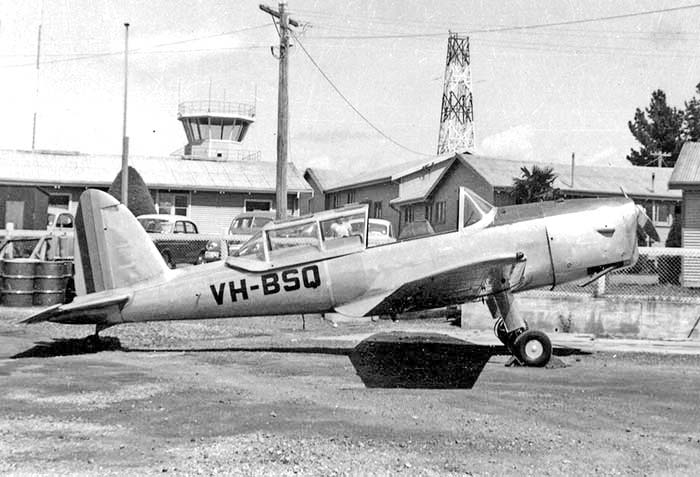
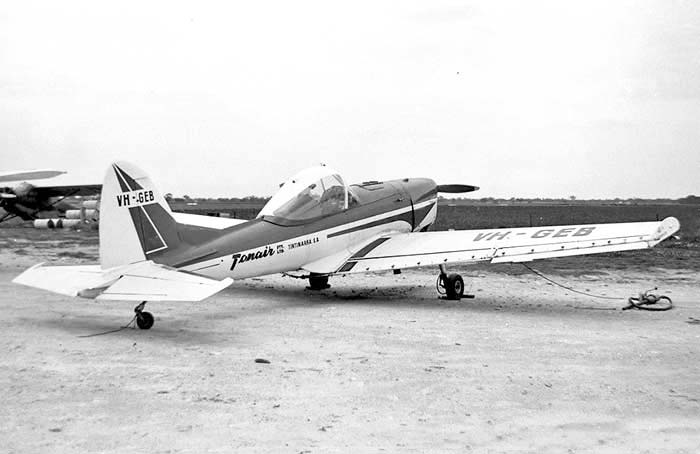
Photo by Geoff Goodall
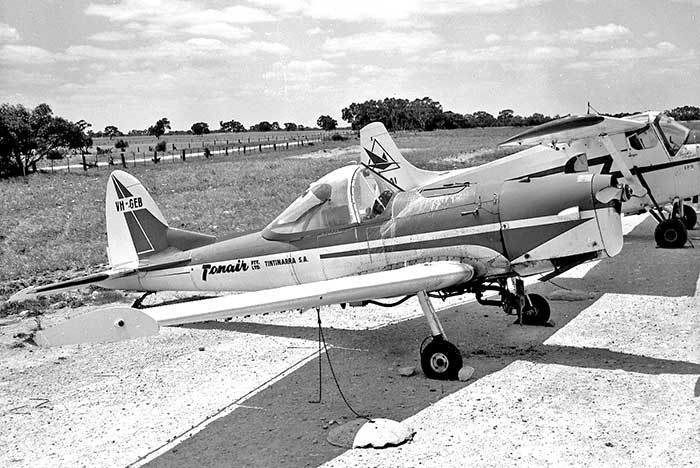
painter when the Spraymaster was completed 18 months earlier. Photo by Geoff Goodall
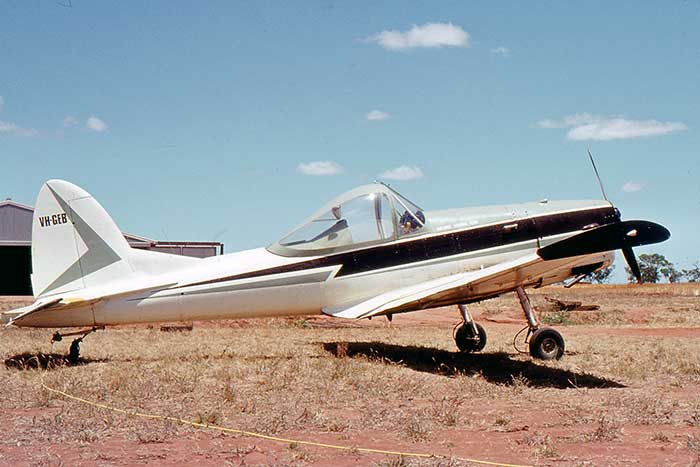
Photo by Nigel Daw
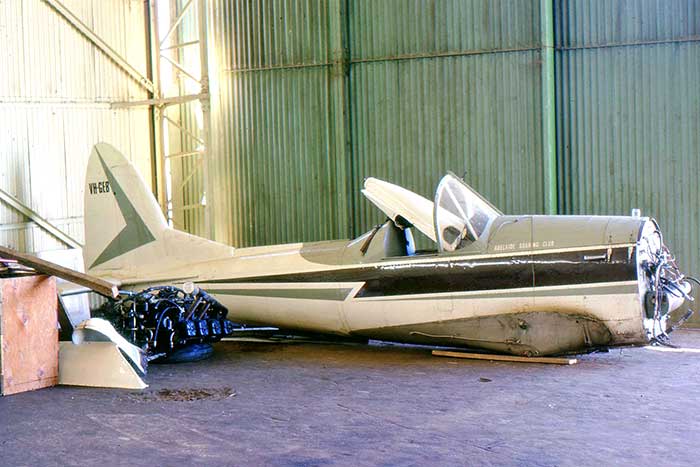
Photo by Nigel Daw
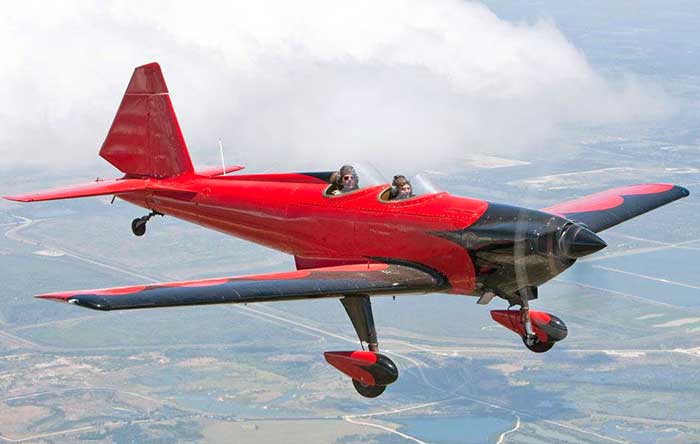
Photo via Graham Orphan
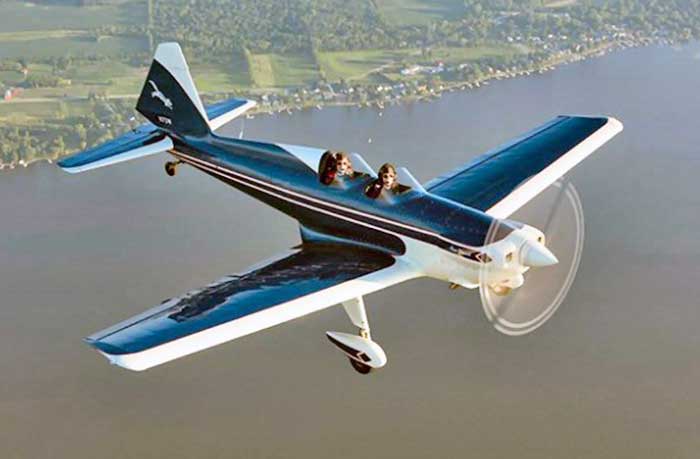

| Based on airframe of Chipmunk VH-RNJ ex G-AOUC, WG412 c/n C1-0486 acquired dismantled from Royal Newcastle Aero Club spare parts stock.. | |
| 28.9.51 Construction date by De Havilland Aircraft Co Ltd at Hawarden, Chester to RAF order Fuselage number DHB f354 7.10.51 Taken on RAF charge as WG412 7.10.51 No.2 Basic Flying Training School, Ansty 23.3.53 No.22 Maintenance Unit, Silloth Down foir storage 9.8.56 Sold to W.S.Shackleton Ltd, London. 16.7.56 Registered G-AOUC: W.S.Shackleton Ltd, 175 Picadilly, London W1. No British CofA. 10.8.56 G-AOUC noted at Kidlington Aerodrome 4.10.56 Cancelled from British Civil Register as sold to Australia 21.12.56 Registered VH-RNJ Royal Newcastle Aero Club, Broadmeadow airfield, Newcastle NSW 20.7.61 Struck-off Register, withdrawn from service Dismantled airframes of VH-RNJ and WB601 held with other RAF Chipmunk components as spare parts by Royal Newcastle Aero Club, which operated a large fleet of Chipmunks. In August 1964 the Club advertised for sale Chipmunk fuselages and wings | |
| .64 | Dismantled airframes WB601 and VH-RNJ plus other parts purchased by Aerostructures Pty Ltd, Hangar 120 Bankstown Airport, Sydney NSW |
| 66 | VH-RNJ's airframe rebuilt and modified by Aerostructures as the prototype Aerostructures Sundowner, powered by a Lycoming O-360 engine. |
| 7.67 | Rolled at Bankstown |
| 25.8.67 | DCA issued test flying permit for two months using allocated registration VH-CXZ |
| 8.67 | Test flown Bankstown |
| 67 | Further modifications carried out by Aerostructures, including wing-tip fuel tanks. Test flown with empty and full fuel tanks. |
| 68 | DCA advised Aerostructures Pty Ltd that it was unable to issue type certification for the Sundowner. It is believed primary reasons were design and stress analysis calculations which had not been completed by Aerostructures' project aeronautical engineer before his death in a Sydney boating accident in 1967. |
| 2.1.68 | VH-CXZ completed with wing tanks and painted VH-CXZ
"John Roulston Aviation Carnarvon WA" was parked in Aerostructures
hangar while the company unsuccessfully attempted to negotiate a
compromise with DCA. |
| 70-72 | Parked outside at Bankstown |
| 28.6.72 | Bill of Sale to John Milton Pty Ltd, Bankstown Airport NSW. Milton was an aircraft dealer. |
| .72 | Acquired by Dean Whitaker, Double Bay, Sydney He owned airworthy Chipmunk VH-GCE and the damaged SA-29 Spraymaster VH-GEB. |
| .72 | Whitaker sold his three Chipmunks to George Doug Warren, Big Spring Texas |
| Shipped to USA | |
| 26.10.72 | Registered N8DW G. Doug Warren, Big Spring Texas |
| Doug Warren registered the three Australian aircraft as DHC-1 Chipmunk Mk.22: N7DW ex VH-GEB N8DW ex VH-CXZ N13DW ex VH-GCE | |
| 2.8.73 | FAA inspection report: Total airframe time 1,005 hrs, Lycoming IO-360-A1A |
| 8.8.73 | US CofA issued in Experimental Exhibition Category |
| 8.3.74 | Bill of Sale to Joe D. Boyd, Lubbock Texas |
| 26.3.76 | Bill of Sale to Joe W. Moore, Pecos Texas |
| 20.5.77 | Bill of Sale to Charles V. P. Ballo, Chattanooga Tennessee |
| 21.11.77 | Bill of Sale to Wayne L Guess, Negley Ohio |
| 22.11.77 | Damaged in forced landing at Walls, Missouri (repaired) |
| 10.11.78 | Bill of Sale to Spinks Industries Inc, Fort Worth Texas |
| 22.7.80 | Bill of Sale to George D Warren, R and D Aircraft Inc, Big Spring Texas |
| 2.5.88 | Bill of Sale to Jerry S. Mills, Monroe North Carolina |
| 16.8.95 | Bill of Sale to Waldron A. Schanz, Merritt Island Florida |
| 15.11.95 | CofA renewed for new engine installation: Lycoming IO-540-C1C5 |
| 9.2.06 | Bill of Sale to Douglas K. Sampson, Franklin Virginia |
| 5.13 | Advertised for sale: hangared at Martinsville VA, total time 1600 hrs, 475 hrs since 1992 rebuild |
| 2.2.15 | Bill of Sale to Tensas Flying Service Inc, St Joseph Louisiana |
| Current |
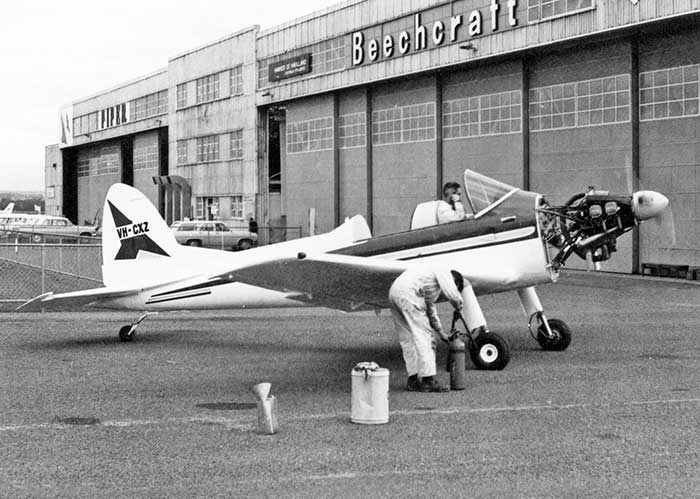
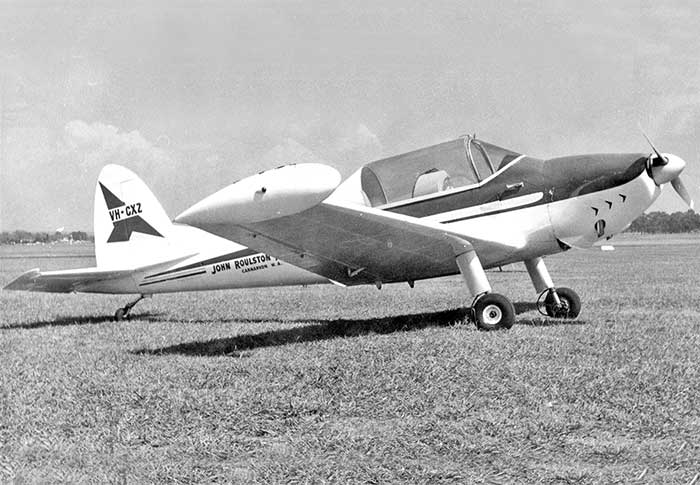
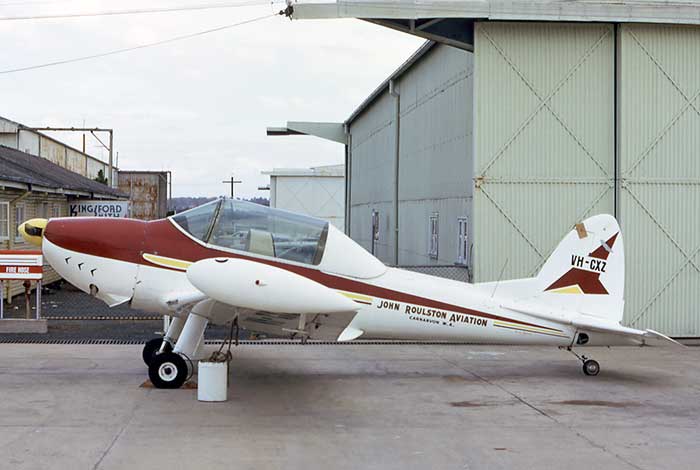
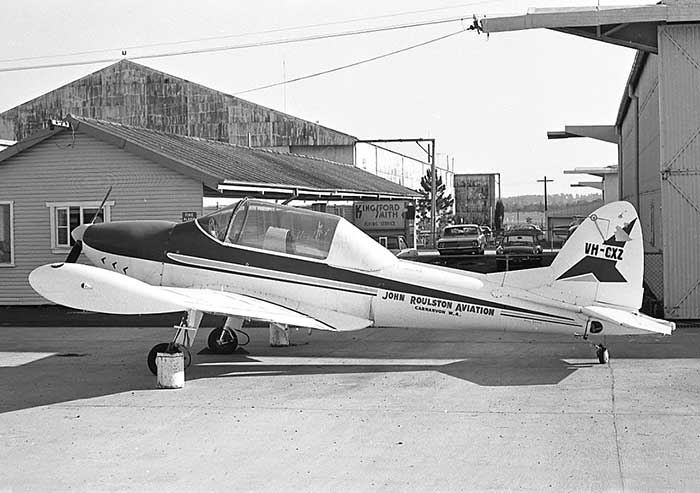
| Aerostructures
Pty Ltd was commissioned by the Sydney owner of airworthy DHC.1
Chipmunk VH-RJK c/n C1-0070 for modifications to partial Sundowner configuration with Lycoming O-360 engine but without wing-tip tanks, retaining its original two-seat cockpit. | |
| Built in 1950 by De Havilland Aircraft Co Ltd at Hawarden, Chester to RAF order. Fuselage number PAC f6 from a batch of fuselages sub-contracted to Percival Aircraft Co. 3.5.50 Delivered to RAF as Chipmunk T.Mk.10 WB629. 3.5.50 RFS Fairoaks 15.6.51 RFS Redhill 11.11.53 No.20 Maintenance Unit, Ashton Down. To non-effective stock 17.8.55 11.9.56 Sold to W.S.Shackleton Ltd, London Dismantled at Ashton Down by Helliwells Ltd acting for W.S.Shacklton, for shipping to Australia. 19.9.57 Registered as Chipmunk T.Mk.10 VH-RVT: Royal Victorian Aero Club, Moorabbin Vic 17.1.64 Sold and reregistered VH-RJK: K.J.Peterson, Proserpine Qld 2.5.67 L.E.McDonnell, Sydney | |
| 6.7.67 | VH-RJK noted at Bankstown |
| .67 | Dr.
Lal McDonnell commissioned Aerostructures Pty Ltd at Bankstown Airport
to modify his Chipmunk VH-RJK to install a Lycoming O-360 engine and
certain Sundowner design features. At that time Aerostructures was challenging DCA's refusal to approve the first complete Sundowner VH-CXZ so McDonnell's Chipmunk was a more conservative modification, without wing-tip tanks and retaining its original two-seat cockpit. |
| 3.68 | VH-RJK
noted in Aerostructures hangar Bankstown, conversion almost completed.
Painted white with gold trim with "Sundowner" on forward fuselage sides |
| 9.5.68 | VH-RJK noted at Bankstown, parked in hangar. Also 8.8.68, 1.11.68 |
| 3.11.68 | visited airshow West Maitland NSW, operating on a DCA Permit to Fly pending formal issue of CofA |
| 12.68 | DCA issued CofA under new aircraft type designation DHC.1/A1 |
| 19.12.68 | VH-RJK DHC.1 Chipmunk T.Mk.10 cancelled from the Australian Civil Aircraft Register |
| 20.12.68 | Registered as DHC.1/A1 VH-RJK: L. E. McDonnell, Sydney NSW |
| 6.4.69 | visited airshow Shepparton Vic |
| 17.1.70 | visited airshow Warrnambool Vic, flew a display in Lycoming Chipmunk demonstration team with VH-RSQ and VH-RVY |
| 19.4.70 | visited airshow Orbost Vic, operated by Aerial Promotions Pty Ltd, flew a display with Lycoming Chipmunk VH-RSQ |
| 19.9.70 | noted at Bankstown |
| 1.2.71 | Change of ownership: Judith W. & J.K.Best, Warwick Qld |
| 28.12.71 | noted at Waikerie SA |
| 17.5.73 | noted at Toowoomba Qld |
| 6.8.74 | noted at Warwick Qld |
| 12.74 | sold to Kevin Cruikshank/ Gliding Club of Western Australia, Cunderdin WA. |
| 12.74 | Doctor Judith Best wrote in AOPA Magazine that she sold RJK to purchase a PA-30 Twin Comanche. While operating RJK she had an under belly auxiliary fuel tank installed and instrumentation for night flying to allow regular long trips to NSW, Victoria and Waikerie SA "RJK taught us an awful lot about flying and never gave us a moment of trouble or one fright." |
| 12.74 | Kevin Cruikshank departed Warwick Qld on delivery flight to WA |
| 29.12.74 | noted at Jandakot Airport, Perth, just arrived from Queensland |
| 11.2.75 | noted at Cunderdin WA at Gliding Club of WA hangar, also 4.5.75 |
| 13.2.75 | Civil Register Change of ownership: Kevin Cruikshank, Perth WA Based at Cunderdin WA operated by Gliding Club of WA as a glider tug |
| 3.1.76 | noted at Cunderdin WA towing gliders |
| 21.5.76 | noted at Kellerberrin WA with under-belly auxiliary fuel tank, at maintenance hangar, also 25.7.76 |
| 30.5.79 | noted at Cunderdin WA |
| 12.10.80 | Damaged, accident at Cunderdin WA |
| 26.8.84 | Damaged, accident at Cunderdin WA |
| 12.7.87 | Damaged, accident at Cunderdin WA |
| Withdrawn from service Cunderdin WA | |
| 7.10 | noted at Cunderdin parked
outside, stripped airframe without tailplane or outer wing sections,
part-way through a rebuild. Lycoming cowlings in place but no engine
fitted/ |
| 13 | stored in a shed on farm of new owner Jim Paynter, Quairading WA |
| Restored to Register to Kevin Cruikshank 24.2.06 and currently registered but status unknown. |
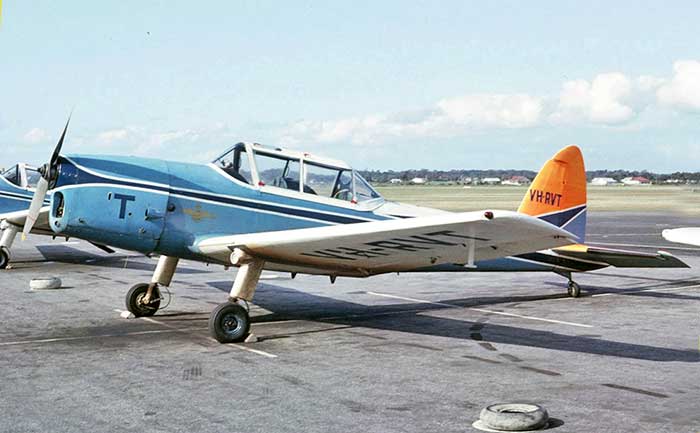
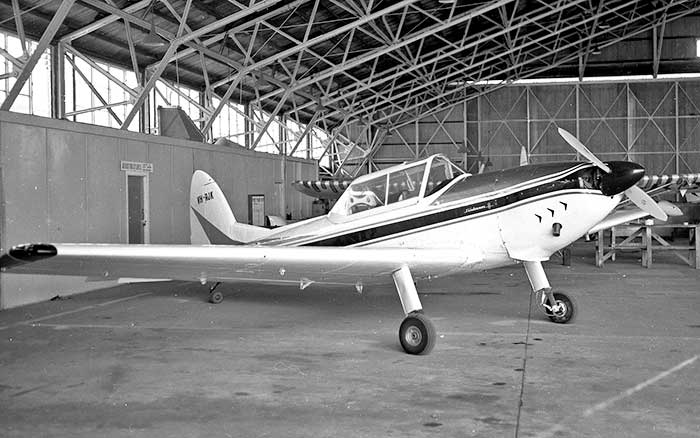
Photo by Geoff Goodall
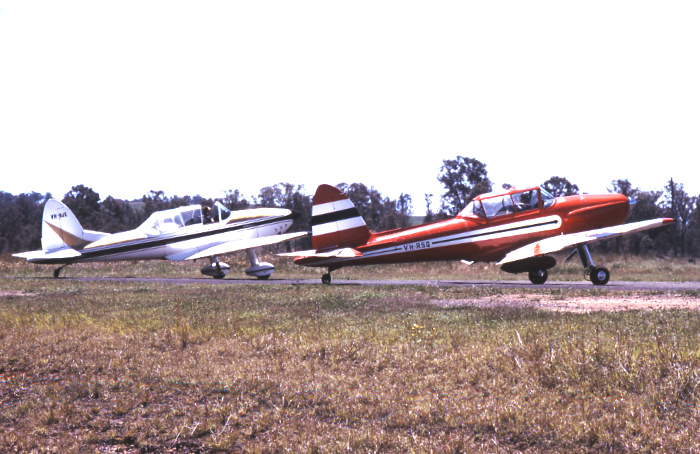
by Keith Fitton's Aerial Promotions Pty Ltd as an aerobatic display team. Photo courtesy Diane Fitton

Photo by Nigel Daw
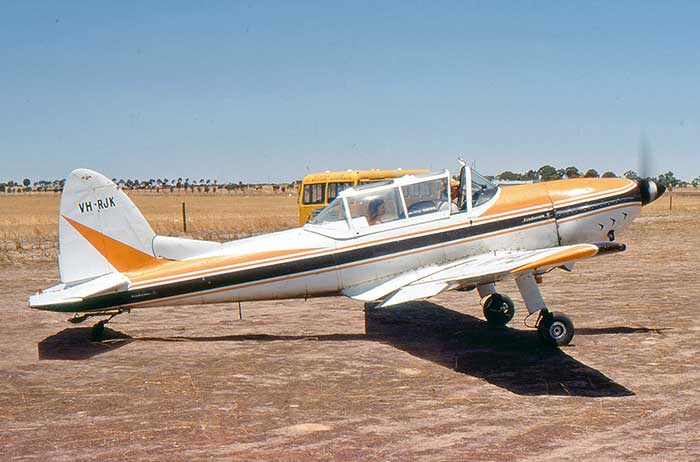
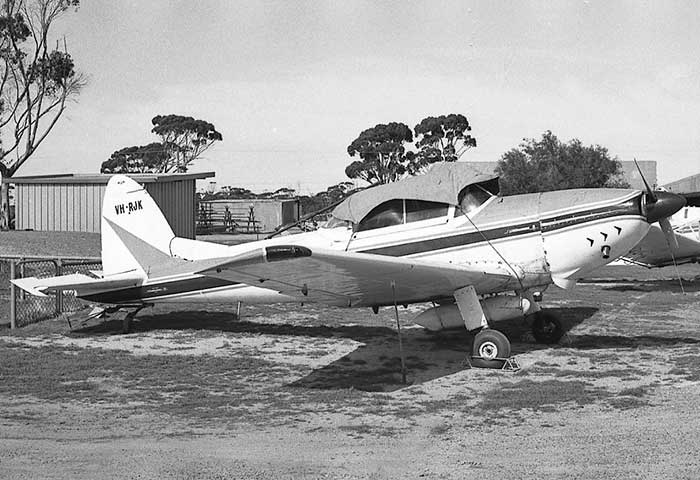
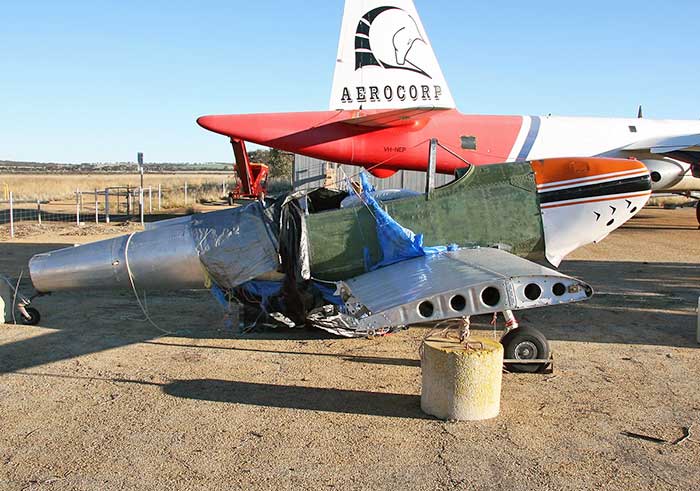
The Neptune VH-NEP behind was retired here after Perth company Aerocorp converted it to an air tanker
but failed to gain any Government fire bombing contracts or support. Photo by Brenden Scott
Included in the move to Canberra by road was one of Aerostructures' better known projects, the Turbine Mustang. CAC Mustang A68-187 was being re-engined with a Rolls Royce Dart turbine engine for owner Hockey Treloar. The job was completed at Canberra and ground run with the turboprop, however it was not flown.
Refer: http://www.goodall.com.au/australian-aviation/mustangs-civil/austcivilmustangs.html
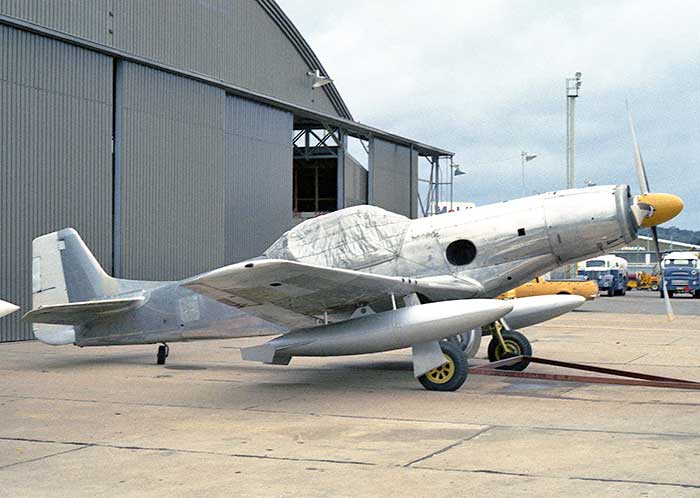
Seen outside the company's hangar at Canberra Airport in April 1974. Photo by John Hopton
- Australian Civil Aircraft Register, Department of Civil Aviation and its successors
- British Civil Aircraft Register: g-info website
- US Civil Aircraft Register
- US Civil Aircraft News No.02, DHC-1 listing, Midland Counties Publications 1977
- Made in Australia, Australian Air Log, July 1966
- Bad Luck Comes in Threes, Australian Air Log, September 1966
- More on The Spraymaster, Australian Air Log, January 1967
- Antipodean Chipmunks, Geoff Goodall, Aviation Historical Society of Australia Journal, April-June 1978
- Chipmunk The First 50 Years, M.D.N.Fisher, R.W.Brown, T.Rothermel, Air Britain Publications 1996
- DHC-1 Chipmunk, Hugh Shields, Rod Brown, Jose Goncalves, Rod Blievers, SBGB Publishing 2009
- The E.P.9 Story, Mike Sasin, Hesperian Press, 2014